close
keyboard_arrow_left
Solutions
close
keyboard_arrow_left
Products
close
Quick Links
-
Smart Beds & Surfaces keyboard_arrow_right
-
Patient Monitoring keyboard_arrow_right
-
Care Communications keyboard_arrow_right
-
Safe Patient Handling & Mobility keyboard_arrow_right
-
Non-Invasive Respiratory Therapy keyboard_arrow_right
-
Surgical Workflow keyboard_arrow_right
-
Precision Positioning keyboard_arrow_right
-
Procedural Connectivity keyboard_arrow_right
-
Diagnostic Cardiology keyboard_arrow_right
-
Physical Exam & Diagnostics keyboard_arrow_right
-
Vision Screening & Diagnostics keyboard_arrow_right
-
View All
keyboard_arrow_left
Services
close
keyboard_arrow_left
Knowledge
close
keyboard_arrow_left
Profile
close


